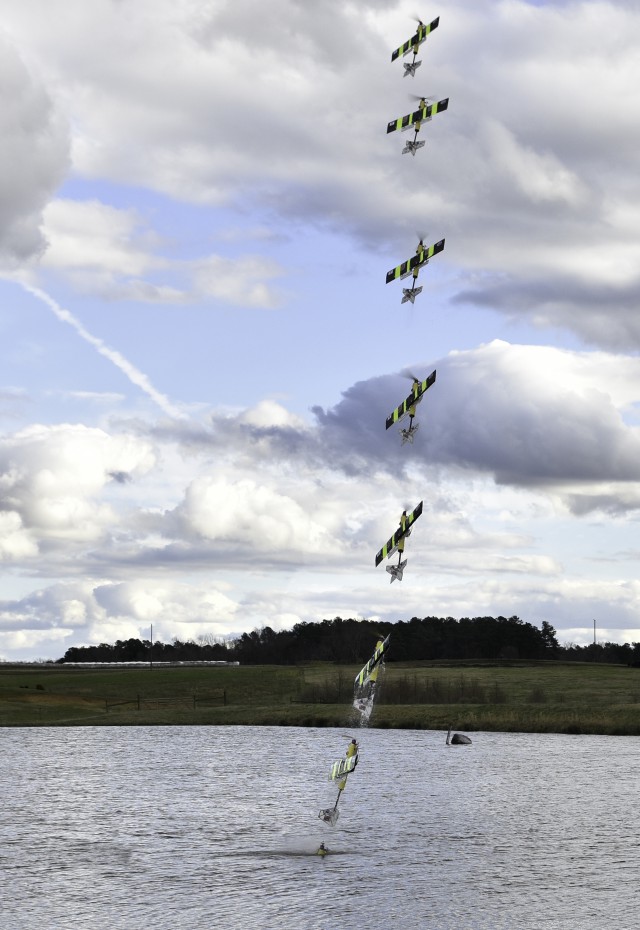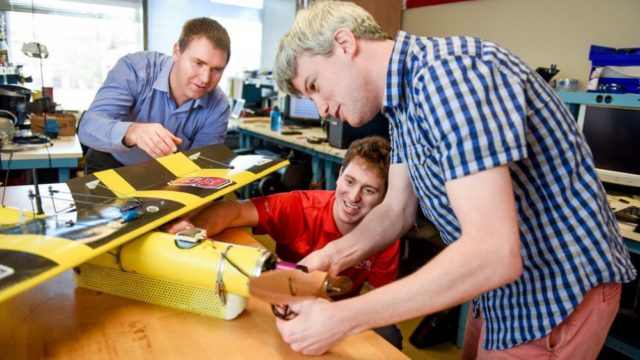Researchers from North Carolina State University have developed an unmanned, fixed-wing aircraft that is capable of traveling both through the air and under the water – transitioning repeatedly between sky and sea. The EagleRay XAV, which was developed with funding and assistance from Teledyne Scientific, holds promise for use in applications such as tracking and observing wildlife.
“Maintaining aerial surveillance can use a lot of energy,” says Warren Weisler, a Ph.D. student at NC State who worked on the EagleRay project. “The EagleRay can conserve energy by spending some of its time in the water.
“For example, the EagleRay could track a fast-moving pod of dolphins from the air, then spend time loitering in the water if the dolphins stop to take advantage of a good feeding spot. The EagleRay could then resume flight when the dolphins begin moving again.”
“The EagleRay could also rapidly move underwater sensors from location to location,” says William Stewart, another NC State Ph.D. student who worked on the project. “It could even perform underwater monitoring that most unmanned aerial vehicles can’t.
“For example, sonar only works underwater. If you’re seeking a sonar target, the EagleRay could fly to a site, submerge to take sonar readings, and then resume flight to take readings elsewhere. Historically, an aircraft would have to drop sonobuoys to collect sonar data.”
The project started when a team of four NC State faculty, led by Matthew Bryant, an assistant professor in NC State’s Department of Mechanical and Aerospace Engineering, won a research contract from Teledyne in 2014. Professors Kara Peters, Ashok Gopalarathnam, and Larry Silverberg served as co-principle investigators on the project. By spring of 2016, Bryant’s team had developed a fully functional prototype – and they published a paper on the work in 2017.
“A key point regarding the EagleRay design is that it is scalable – you can make larger or smaller models as needed,” Stewart says. “It really depends on the size of the desired payload, how long you’d need it to operate, and so on.”

Time-lapse image of the EagleRay transitioning from underwater to the air. Image credit: Matthew Bryant.
The current model of EagleRay has a wingspan of 59 inches and is 55 inches long, weighing in at 12.6 pounds. It has a dual-use propeller, powered by an electric motor, that propels it through both air and water.
“We’re currently developing a custom controller for the EagleRay,” Weisler says. “Existing controllers aren’t designed for a vehicle that transitions from air to sea and back again – they’re designed to be one or the other, with no transition stage.”
The researchers are also refining a dynamic model of the EagleRay, for use in simulations that can be used for training purposes, to predict performance under various conditions and to refine the vehicle design.
“This project has been extremely challenging and rewarding,” Weisler says.
“Seeing it fly during field trials was exhilarating,” says Stewart.
The paper, “Testing and Characterization of a Fixed Wing Cross-Domain Unmanned Vehicle Operating in Aerial and Underwater Environments,” is published in the IEEE Journal of Oceanic Engineering. Weisler is lead author of the paper. Co-authors include Stewart, Bryant, Peters, Gopalarathnam and Mark Anderson of Teledyne.
Source: NC State University News


Very Cool. Great Job.
Best of Luck.